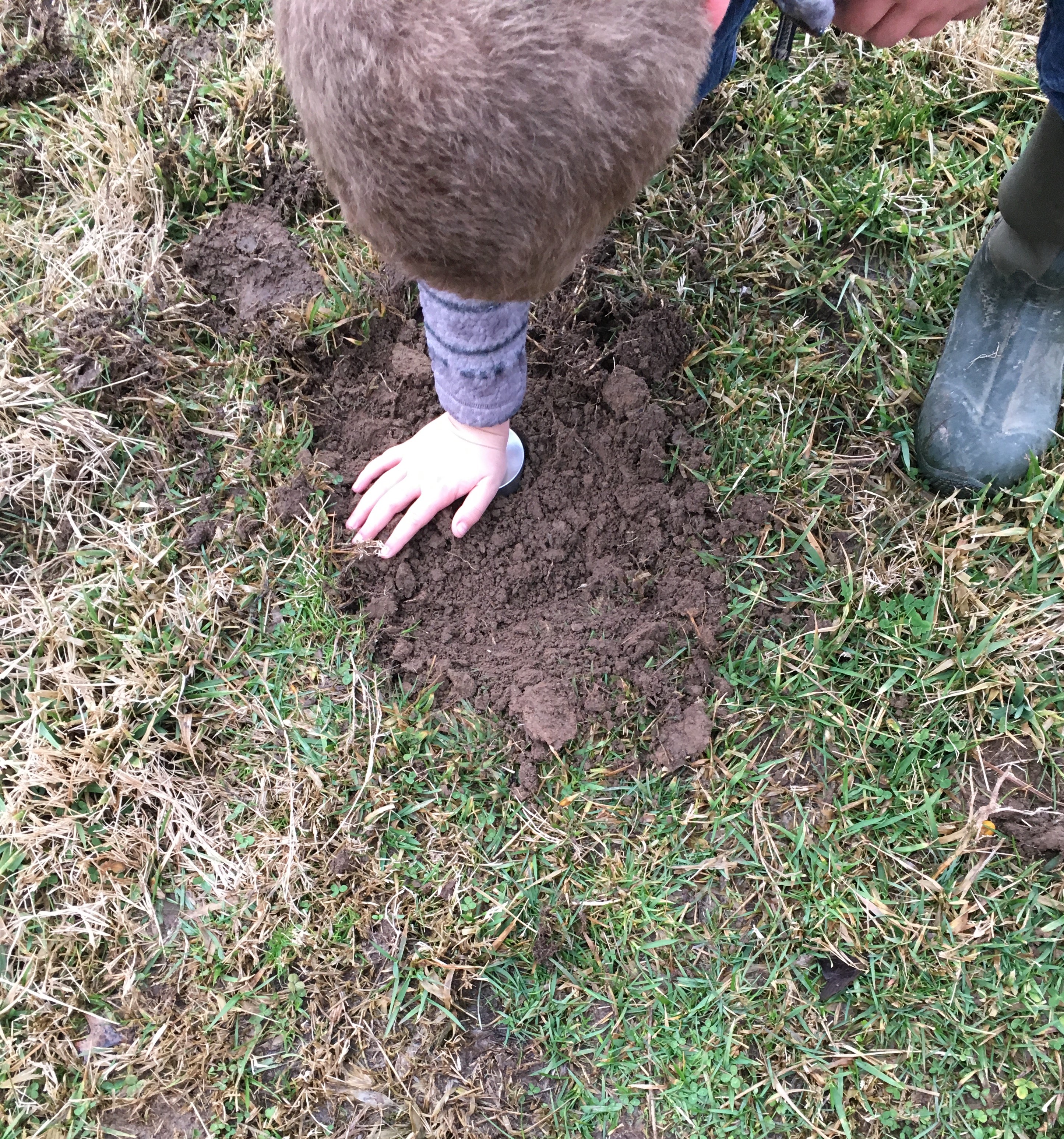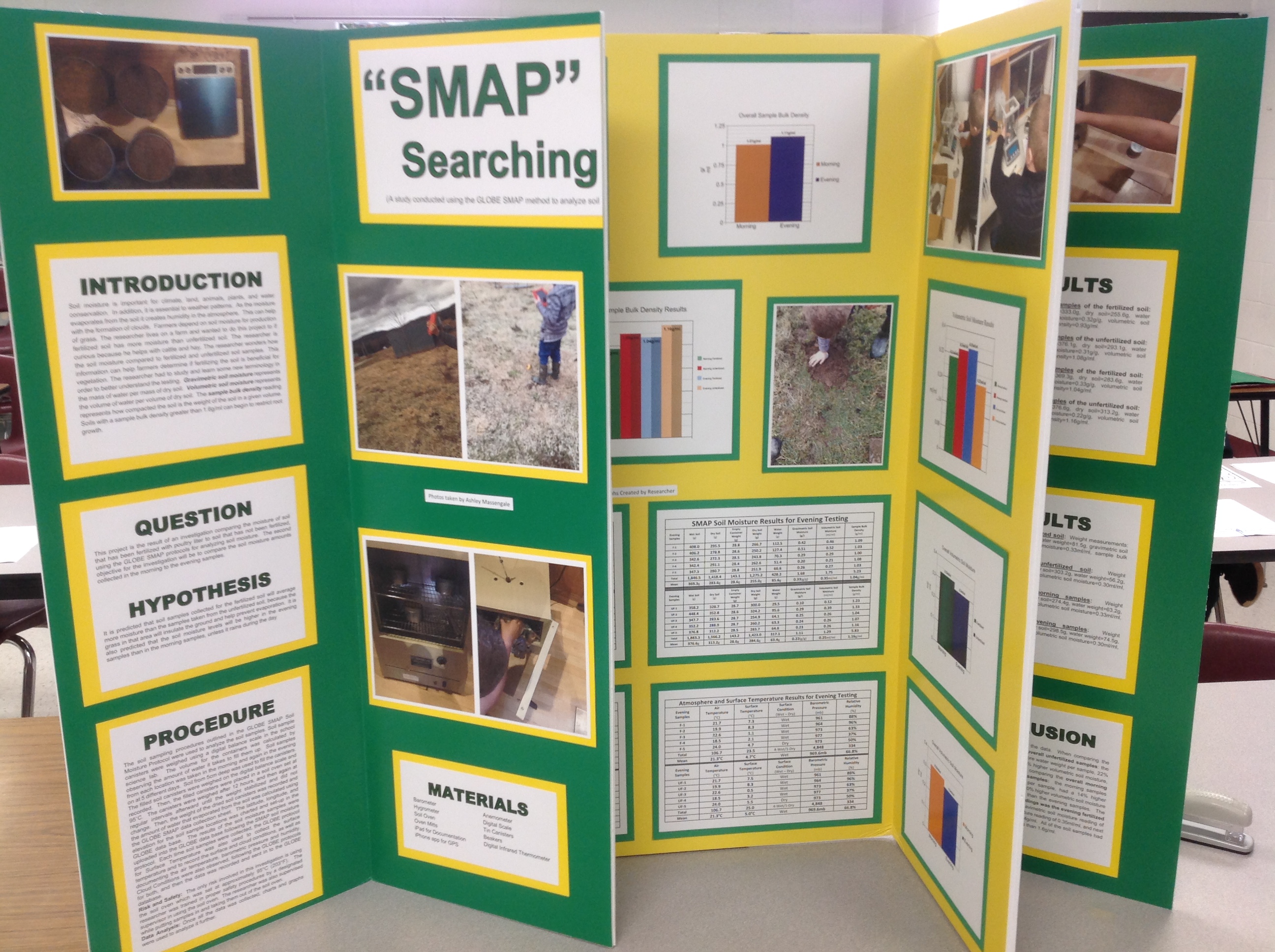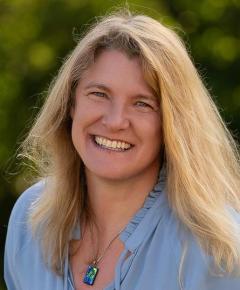"SMAP . . . . Searching for Moisture" 5th Grade - 2020 SRS - 2020 SRS
GLOBE Breadcrumb
- Home>
- 2020 SRS
Open social media sharing options menu
 Share
Share
GLOBE Side Navigation
Site Name
2020 Student Research Symposium (SRS)
Message Boards
Project Title: "SMAP . . . . Searching for Moisture"
School Name: Alpena Elementary/Middle School
Teacher Name: Roger Rose
Student Name: Grady Massengale
Grade Level: 5th grade
Project Description: (A study conducted using the GLOBE SMAP method to analyze soil moisture in fertilized and unfertilized soil during the morning and evening)
Abstract: This was an investigation comparing moisture levels in soil fertilized with poultry litter and non-fertilized soil, in the morning and evening. It is predicted that the fertilized soil samples in the evening will have the highest moisture levels. The GLOBE SMAP Soil Moisture Protocol was used. Volume and weight of soil collection canisters was calculated. Then, in the morning and evening on the fertilized soil and unfertilized soil, samples were collected and dried in a soil oven. Wet soil weight, dry soil weight, water weight, gravimetric soil moisture, volumetric soil moisture, sample bulk density were calculated by entering the information into the GLOBE SMAP Soil Moisture website and analyzed with a statistics t-Test. Fertilized morning samples: wet soil=333.0g, dry soil=255.6g, water weight=77.4g, gravimetric soil moisture=0.32g/g, volumetric soil moisture=0.31ml/ml, bulk density=0.93g/ml. Fertilized evening samples: wet soil=369.3g, dry soil=283.6g, water weight=85.6g, gravimetric soil moisture=0.33g/g, volumetric soil moisture=0.35ml/ml, bulk density=1.04g/ml. Unfertilized morning samples: wet soil=376.1g, dry soil=293.1g, water weight=48.9g, gravimetric soil moisture=0.31g/g, volumetric soil moisture=0.34ml/ml, bulk density=1.08g/ml. Unfertilized evening samples: wet soil=376.6g, dry soil=313.2g, water weight=63.4g, gravimetric soil moisture=0.22g/g, volumetric soil moisture=0.25ml/ml, bulk density=1.16g/ml. The hypothesis was supported by the data. Fertilized samples averaged 45% more water weight, 22% higher gravimetric soil moisture, 10% higher volumetric soil moisture, and was 12% less dense. Morning samples averages 15% less water weight, had a 14% higher gravimetric soil moisture reading, a 10% higher volumetric soil moisture reading, and was 10% less dense than the evening samples. Evening fertilized samples had the best results.
Atmosphere Protocols: Air Temp, Barometric Pressure, Clouds, Relative Humidity, Surface temp., Pedosphere Protocol: SMAP Soil Moisture Block Pattern
Language: English
Video URL:https://youtu.be/BnZqx4xL-9c
![]()

![]()
School Name: Alpena Elementary/Middle School
Teacher Name: Roger Rose
Student Name: Grady Massengale
Grade Level: 5th grade
Project Description: (A study conducted using the GLOBE SMAP method to analyze soil moisture in fertilized and unfertilized soil during the morning and evening)
Abstract: This was an investigation comparing moisture levels in soil fertilized with poultry litter and non-fertilized soil, in the morning and evening. It is predicted that the fertilized soil samples in the evening will have the highest moisture levels. The GLOBE SMAP Soil Moisture Protocol was used. Volume and weight of soil collection canisters was calculated. Then, in the morning and evening on the fertilized soil and unfertilized soil, samples were collected and dried in a soil oven. Wet soil weight, dry soil weight, water weight, gravimetric soil moisture, volumetric soil moisture, sample bulk density were calculated by entering the information into the GLOBE SMAP Soil Moisture website and analyzed with a statistics t-Test. Fertilized morning samples: wet soil=333.0g, dry soil=255.6g, water weight=77.4g, gravimetric soil moisture=0.32g/g, volumetric soil moisture=0.31ml/ml, bulk density=0.93g/ml. Fertilized evening samples: wet soil=369.3g, dry soil=283.6g, water weight=85.6g, gravimetric soil moisture=0.33g/g, volumetric soil moisture=0.35ml/ml, bulk density=1.04g/ml. Unfertilized morning samples: wet soil=376.1g, dry soil=293.1g, water weight=48.9g, gravimetric soil moisture=0.31g/g, volumetric soil moisture=0.34ml/ml, bulk density=1.08g/ml. Unfertilized evening samples: wet soil=376.6g, dry soil=313.2g, water weight=63.4g, gravimetric soil moisture=0.22g/g, volumetric soil moisture=0.25ml/ml, bulk density=1.16g/ml. The hypothesis was supported by the data. Fertilized samples averaged 45% more water weight, 22% higher gravimetric soil moisture, 10% higher volumetric soil moisture, and was 12% less dense. Morning samples averages 15% less water weight, had a 14% higher gravimetric soil moisture reading, a 10% higher volumetric soil moisture reading, and was 10% less dense than the evening samples. Evening fertilized samples had the best results.
Atmosphere Protocols: Air Temp, Barometric Pressure, Clouds, Relative Humidity, Surface temp., Pedosphere Protocol: SMAP Soil Moisture Block Pattern
Language: English
Video URL:https://youtu.be/BnZqx4xL-9c


From Dr. Dixon Butler (https://www.globe.gov/web/dixon.butler): Your project is a creative use of the SMAP Protocol. You were thorough in your testing of your hypothesis. How might your results help farming practices? Why do you think the soil had a higher moisture content when it was fertilized? Did doing this research give you a new approach to answering questions?
Hi Grady,
My name is Ruth Varner and I am a professor in Earth Science at UNH. I study the greenhouse gas methane and how much is emitted from natural and human managed sources.
Great to hear about your motivation for your research - your farm! I used to spend my summers on my grandparents farm and spent a lot of time looking at the soil too.
Your results are very interesting. Did you notice if there were any differences in your plots you took soil samples related to the vegetation covre that might influence the soil moisture differences?
I realy liek yoru results in the bar plots - this really helps visualize your data and point out the differences you observed.
Thanks for sharing this work - I hope you ocntinue to be interested in environmental science!
Excellent job!
Ruth
My name is Ruth Varner and I am a professor in Earth Science at UNH. I study the greenhouse gas methane and how much is emitted from natural and human managed sources.
Great to hear about your motivation for your research - your farm! I used to spend my summers on my grandparents farm and spent a lot of time looking at the soil too.
Your results are very interesting. Did you notice if there were any differences in your plots you took soil samples related to the vegetation covre that might influence the soil moisture differences?
I realy liek yoru results in the bar plots - this really helps visualize your data and point out the differences you observed.
Thanks for sharing this work - I hope you ocntinue to be interested in environmental science!
Excellent job!
Ruth
Hello Grady.
My name is Dr. Jodi Haney. I am a professor emeritus (which means retired, but still VERY active ;-) at Bowling Green State University in Ohio. My students at the university collect soil moisture data too using the SMAP protocol. Your work is very interesting for sure. I'm glad you chose something to research that interests you and relates to your world... FARMING. Your methods are really solid and follow the GLOBE protocol closely... great! I like that you included all the data obtained from your study and that your conclusions are supported by your findings. Your findings stated as percentage increase or decreases helps summarize your findings nicely. I was surprised to see such a difference between fertilized and unfertilized soil as well as morning versus nighttime. Why do you think these differences existed? When you say the nighttime fertilized soil moisture was the "BEST", explain what you mean by best in terms of farming practices. Is there such a thing as too much moisture? How do your findings match up to optimal soil moisture? Finally, I wonder about the bulk density data means? The fertilized soil was LESS dense... what might that mean for farming? In other words... how does the fertilize help exactly... what's going on? I hope you continue your study in the future and keep contributing data to GLOBE. We need YOU and the good work you do!
My name is Dr. Jodi Haney. I am a professor emeritus (which means retired, but still VERY active ;-) at Bowling Green State University in Ohio. My students at the university collect soil moisture data too using the SMAP protocol. Your work is very interesting for sure. I'm glad you chose something to research that interests you and relates to your world... FARMING. Your methods are really solid and follow the GLOBE protocol closely... great! I like that you included all the data obtained from your study and that your conclusions are supported by your findings. Your findings stated as percentage increase or decreases helps summarize your findings nicely. I was surprised to see such a difference between fertilized and unfertilized soil as well as morning versus nighttime. Why do you think these differences existed? When you say the nighttime fertilized soil moisture was the "BEST", explain what you mean by best in terms of farming practices. Is there such a thing as too much moisture? How do your findings match up to optimal soil moisture? Finally, I wonder about the bulk density data means? The fertilized soil was LESS dense... what might that mean for farming? In other words... how does the fertilize help exactly... what's going on? I hope you continue your study in the future and keep contributing data to GLOBE. We need YOU and the good work you do!











